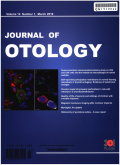- 钛学术文献服务平台 \
- 学术期刊 \
- 医药卫生期刊 \
- 五官科学期刊 \
- 中华耳科学杂志(英文版)期刊 \
Methods for measuring pre-, intra-, and postoperative skin thickness for cochlear implants
Methods for measuring pre-, intra-, and postoperative skin thickness for cochlear implants
基本信息来源于合作网站,原文需代理用户跳转至来源网站获取
摘要:
Objective:This study was conducted to determine whether there is a reliable method for measuring the thickness of the retroauricular skin before, during, and after cochlear implantation, which allows the assessment of the optimal force of the external magnet of the cochlear implant (CI). Methods:The retroauricular skin thickness of 83 patients who received a CI was measured using three different methods. The thickness was measured on pre- and postoperative CT images, as well as intra-operatively. The magnet category chosen by the surgeon was recorded when the implant was switched on and during the first follow-up visit. Correlation analyses were performed on the different skin thickness measurements and between the skin thickness and magnet strength categories. Results:Only six patients required an exchange of the magnet until the follow-up. Although the median absolute thickness differed significantly between the three measures (p<0.0001), their thickness values showed highly significant correlations (Pearson's r = 0.457-0.585; p < 0.01). In addition, magnet strength, was significantly correlated with the flap thickness determined pre-, post-, and during surgery. The lowest correlation with magnet strength was found in the intraoperative needle method. Conclusion:All three measurements methods provided a suitable base for determining the ideal mag-netic force. However, of particular interest were the pre-and postoperative CT measurements. The first enabled the early assessment of the required magnetic strength and thus a timely postoperative supply, whereas the latter helped to estimate the need for magnetic strength reduction during follow-up care and the feasibility of an early swith-on.

推荐文章
The in situ spectral methods for examining redox status of c-type cytochromes in metal-reducing/oxid
c-type cytochrome
In situ spectroscopy
Intact cells
Metal reducing bacteria
Fe(Ⅱ) oxidation bacteria
乙肝血清标志物阳性孕妇检测乙肝Pre-S1抗原的意义
Pre-S1抗原
乙肝标志物
酶联免疫吸附法
孕妇
PRE-084预处理对缺血再灌注损伤大鼠心肌细胞凋亡的影响
缺血再灌注损伤
PRE-084
心肌细胞凋亡
Sigma-1受体
Bcl-2蛋白
Bax蛋白
实验研究
内容分析
关键词云
关键词热度
相关文献总数
(/次)
(/年)
文献信息
| 篇名 | Methods for measuring pre-, intra-, and postoperative skin thickness for cochlear implants | ||
| 来源期刊 | 中华耳科学杂志(英文版) | 学科 | |
| 关键词 | |||
| 年,卷(期) | 2022,(2) | 所属期刊栏目 | Research Articles |
| 研究方向 | 页码范围 | 72-77 | |
| 页数 | 6页 | 分类号 | |
| 字数 | 语种 | 英文 | |
| DOI | |||
五维指标
引文网络
引文网络
二级参考文献 (0)
共引文献 (0)
参考文献 (0)
节点文献
引证文献 (0)
同被引文献 (0)
二级引证文献 (0)
2022(0)
- 参考文献(0)
- 二级参考文献(0)
- 引证文献(0)
- 二级引证文献(0)
引文网络交叉学科
相关学者/机构
期刊影响力
中华耳科学杂志(英文版)
主办单位:
解放军总医院耳鼻咽喉科研究所
出版周期:
季刊
ISSN:
1672-2930
CN:
11-4883/R
开本:
出版地:
北京市复兴路28号
邮发代号:
创刊时间:
语种:
eng
出版文献量(篇)
450
总下载数(次)
0
总被引数(次)
399
期刊文献
相关文献
推荐文献
- 期刊分类
- 期刊(年)
- 期刊(期)
- 期刊推荐

 免费查重
免费查重










